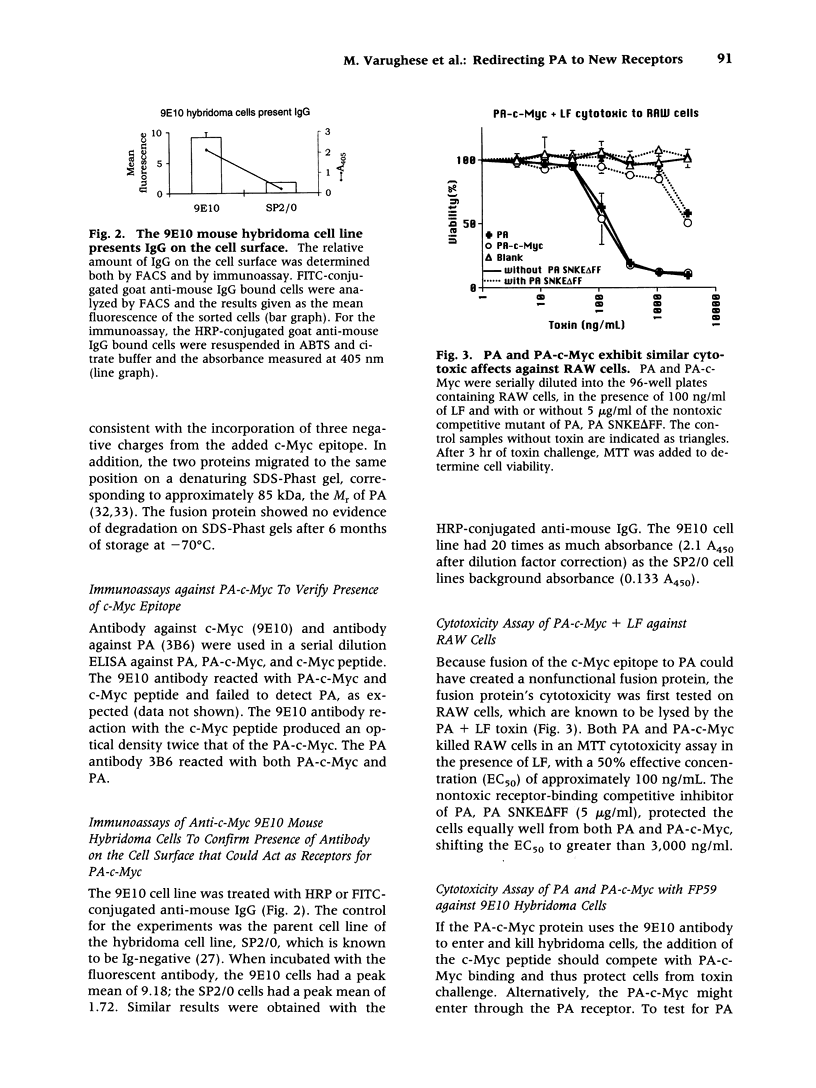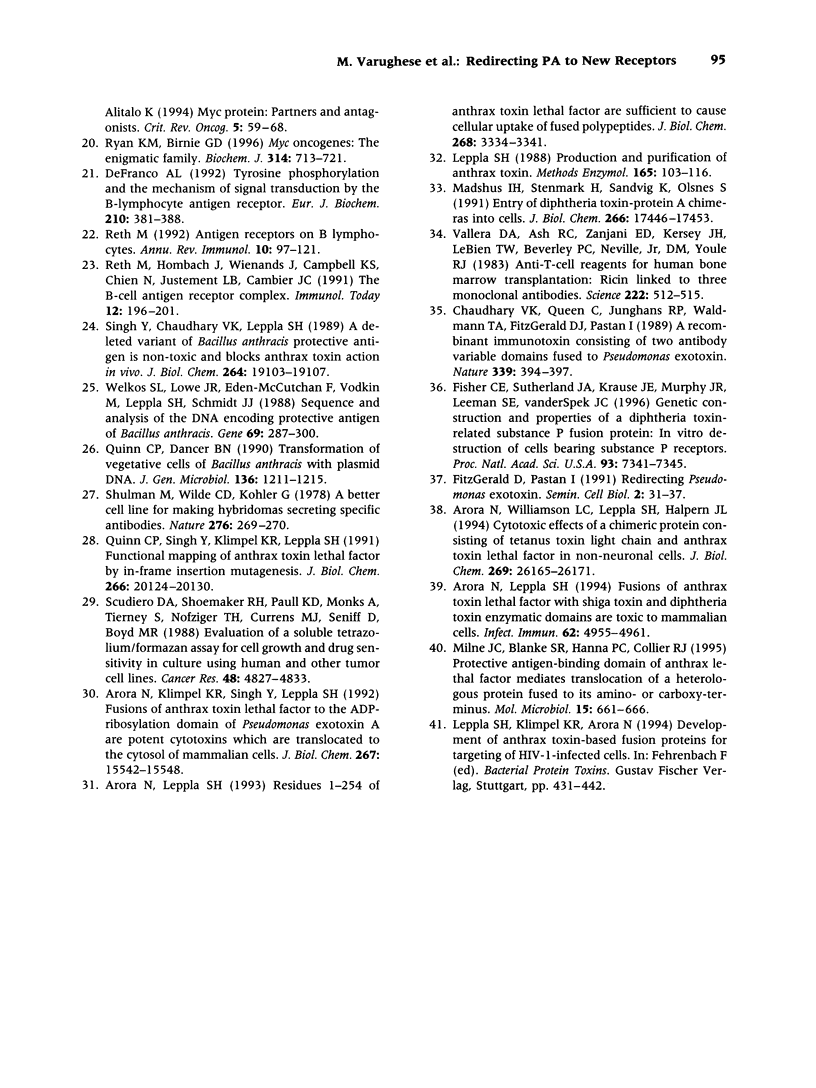Abstract
BACKGROUND: Anthrax toxin, secreted by Bacillus anthracis, consists of protective antigen (PA) and either lethal factor (LF) or edema factor (EF). PA, the receptor-binding component of the toxin, translocates LF or EF into the cytosol, where the latter proteins exert their toxic effects. We hypothesized that anthrax toxin fusion proteins could be used to kill virus-infected cells and tumor cells, if PA could be redirected to unique receptors found only on these cells. MATERIALS AND METHODS: To test this hypothesis in a model system, amino acids 410-419 of the human p62(c-myc) epitope were fused to the C-terminus of PA to redirect PA to the c-Myc-specific hybridoma cell line 9E10. RESULTS: The PA-c-Myc fusion protein killed both mouse macrophages and 9E10 hybridoma cells when administered with LF or an LF fusion protein (FP59), respectively. Similar results were obtained with PA, which suggests that PA-c-Myc used the endogenous PA receptor to enter the cells. By blocking the endogenous PA receptors on 9E10 cells with the competitive inhibitor PA SNKEDeltaFF, the PA-c-Myc was directed to an alternate receptor, i.e., the anti-c-Myc antibodies presented on the cell surface. The c-Myc IgG were proven to act as receptors because the addition of a synthetic peptide containing the c-Myc epitope along with PA SNKEDeltaFF further reduced the toxicity of PA-c-Myc + FP59. CONCLUSION: This study shows that PA can be redirected to alternate receptors by adding novel epitopes to the C-terminus of PA, enabling the creation of cell-directed toxins for therapeutic purposes.
Full text
PDF








Selected References
These references are in PubMed. This may not be the complete list of references from this article.
- Arora N., Klimpel K. R., Singh Y., Leppla S. H. Fusions of anthrax toxin lethal factor to the ADP-ribosylation domain of Pseudomonas exotoxin A are potent cytotoxins which are translocated to the cytosol of mammalian cells. J Biol Chem. 1992 Aug 5;267(22):15542–15548. [PubMed] [Google Scholar]
- Arora N., Leppla S. H. Fusions of anthrax toxin lethal factor with shiga toxin and diphtheria toxin enzymatic domains are toxic to mammalian cells. Infect Immun. 1994 Nov;62(11):4955–4961. doi: 10.1128/iai.62.11.4955-4961.1994. [DOI] [PMC free article] [PubMed] [Google Scholar]
- Arora N., Leppla S. H. Residues 1-254 of anthrax toxin lethal factor are sufficient to cause cellular uptake of fused polypeptides. J Biol Chem. 1993 Feb 15;268(5):3334–3341. [PubMed] [Google Scholar]
- Arora N., Williamson L. C., Leppla S. H., Halpern J. L. Cytotoxic effects of a chimeric protein consisting of tetanus toxin light chain and anthrax toxin lethal factor in non-neuronal cells. J Biol Chem. 1994 Oct 21;269(42):26165–26171. [PubMed] [Google Scholar]
- BEALL F. A., TAYLOR M. J., THORNE C. B. Rapid lethal effect in rats of a third component found upon fractionating the toxin of Bacillus anthracis. J Bacteriol. 1962 Jun;83:1274–1280. doi: 10.1128/jb.83.6.1274-1280.1962. [DOI] [PMC free article] [PubMed] [Google Scholar]
- Chaudhary V. K., Queen C., Junghans R. P., Waldmann T. A., FitzGerald D. J., Pastan I. A recombinant immunotoxin consisting of two antibody variable domains fused to Pseudomonas exotoxin. Nature. 1989 Jun 1;339(6223):394–397. doi: 10.1038/339394a0. [DOI] [PubMed] [Google Scholar]
- DeFranco A. L. Tyrosine phosphorylation and the mechanism of signal transduction by the B-lymphocyte antigen receptor. Eur J Biochem. 1992 Dec 1;210(2):381–388. doi: 10.1111/j.1432-1033.1992.tb17432.x. [DOI] [PubMed] [Google Scholar]
- Evan G. I., Lewis G. K., Ramsay G., Bishop J. M. Isolation of monoclonal antibodies specific for human c-myc proto-oncogene product. Mol Cell Biol. 1985 Dec;5(12):3610–3616. doi: 10.1128/mcb.5.12.3610. [DOI] [PMC free article] [PubMed] [Google Scholar]
- Ezzell J. W., Ivins B. E., Leppla S. H. Immunoelectrophoretic analysis, toxicity, and kinetics of in vitro production of the protective antigen and lethal factor components of Bacillus anthracis toxin. Infect Immun. 1984 Sep;45(3):761–767. doi: 10.1128/iai.45.3.761-767.1984. [DOI] [PMC free article] [PubMed] [Google Scholar]
- Fisher C. E., Sutherland J. A., Krause J. E., Murphy J. R., Leeman S. E., vanderSpek J. C. Genetic construction and properties of a diphtheria toxin-related substance P fusion protein: in vitro destruction of cells bearing substance P receptors. Proc Natl Acad Sci U S A. 1996 Jul 9;93(14):7341–7345. doi: 10.1073/pnas.93.14.7341. [DOI] [PMC free article] [PubMed] [Google Scholar]
- FitzGerald D., Pastan I. Redirecting Pseudomonas exotoxin. Semin Cell Biol. 1991 Feb;2(1):31–37. [PubMed] [Google Scholar]
- Friedlander A. M. Macrophages are sensitive to anthrax lethal toxin through an acid-dependent process. J Biol Chem. 1986 Jun 5;261(16):7123–7126. [PubMed] [Google Scholar]
- Gordon V. M., Leppla S. H., Hewlett E. L. Inhibitors of receptor-mediated endocytosis block the entry of Bacillus anthracis adenylate cyclase toxin but not that of Bordetella pertussis adenylate cyclase toxin. Infect Immun. 1988 May;56(5):1066–1069. doi: 10.1128/iai.56.5.1066-1069.1988. [DOI] [PMC free article] [PubMed] [Google Scholar]
- Hanna P. C., Kochi S., Collier R. J. Biochemical and physiological changes induced by anthrax lethal toxin in J774 macrophage-like cells. Mol Biol Cell. 1992 Nov;3(11):1269–1277. doi: 10.1091/mbc.3.11.1269. [DOI] [PMC free article] [PubMed] [Google Scholar]
- Klimpel K. R., Molloy S. S., Thomas G., Leppla S. H. Anthrax toxin protective antigen is activated by a cell surface protease with the sequence specificity and catalytic properties of furin. Proc Natl Acad Sci U S A. 1992 Nov 1;89(21):10277–10281. doi: 10.1073/pnas.89.21.10277. [DOI] [PMC free article] [PubMed] [Google Scholar]
- Kolodziej P. A., Young R. A. Epitope tagging and protein surveillance. Methods Enzymol. 1991;194:508–519. doi: 10.1016/0076-6879(91)94038-e. [DOI] [PubMed] [Google Scholar]
- Koskinen P. J., Alitalo K. Role of myc amplification and overexpression in cell growth, differentiation and death. Semin Cancer Biol. 1993 Feb;4(1):3–12. [PubMed] [Google Scholar]
- Leppla S. H. Production and purification of anthrax toxin. Methods Enzymol. 1988;165:103–116. doi: 10.1016/s0076-6879(88)65019-1. [DOI] [PubMed] [Google Scholar]
- Little S. F., Leppla S. H., Cora E. Production and characterization of monoclonal antibodies to the protective antigen component of Bacillus anthracis toxin. Infect Immun. 1988 Jul;56(7):1807–1813. doi: 10.1128/iai.56.7.1807-1813.1988. [DOI] [PMC free article] [PubMed] [Google Scholar]
- Madshus I. H., Stenmark H., Sandvig K., Olsnes S. Entry of diphtheria toxin-protein A chimeras into cells. J Biol Chem. 1991 Sep 15;266(26):17446–17453. [PubMed] [Google Scholar]
- Milne J. C., Blanke S. R., Hanna P. C., Collier R. J. Protective antigen-binding domain of anthrax lethal factor mediates translocation of a heterologous protein fused to its amino- or carboxy-terminus. Mol Microbiol. 1995 Feb;15(4):661–666. doi: 10.1111/j.1365-2958.1995.tb02375.x. [DOI] [PubMed] [Google Scholar]
- Milne J. C., Furlong D., Hanna P. C., Wall J. S., Collier R. J. Anthrax protective antigen forms oligomers during intoxication of mammalian cells. J Biol Chem. 1994 Aug 12;269(32):20607–20612. [PubMed] [Google Scholar]
- Perelle S., Gibert M., Boquet P., Popoff M. R. Characterization of Clostridium perfringens iota-toxin genes and expression in Escherichia coli. Infect Immun. 1993 Dec;61(12):5147–5156. doi: 10.1128/iai.61.12.5147-5156.1993. [DOI] [PMC free article] [PubMed] [Google Scholar]
- Petosa C., Collier R. J., Klimpel K. R., Leppla S. H., Liddington R. C. Crystal structure of the anthrax toxin protective antigen. Nature. 1997 Feb 27;385(6619):833–838. doi: 10.1038/385833a0. [DOI] [PubMed] [Google Scholar]
- Quinn C. P., Dancer B. N. Transformation of vegetative cells of Bacillus anthracis with plasmid DNA. J Gen Microbiol. 1990 Jul;136(7):1211–1215. doi: 10.1099/00221287-136-7-1211. [DOI] [PubMed] [Google Scholar]
- Quinn C. P., Singh Y., Klimpel K. R., Leppla S. H. Functional mapping of anthrax toxin lethal factor by in-frame insertion mutagenesis. J Biol Chem. 1991 Oct 25;266(30):20124–20130. [PubMed] [Google Scholar]
- Ramsay G., Evan G. I., Bishop J. M. The protein encoded by the human proto-oncogene c-myc. Proc Natl Acad Sci U S A. 1984 Dec;81(24):7742–7746. doi: 10.1073/pnas.81.24.7742. [DOI] [PMC free article] [PubMed] [Google Scholar]
- Reth M. Antigen receptors on B lymphocytes. Annu Rev Immunol. 1992;10:97–121. doi: 10.1146/annurev.iy.10.040192.000525. [DOI] [PubMed] [Google Scholar]
- Reth M., Hombach J., Wienands J., Campbell K. S., Chien N., Justement L. B., Cambier J. C. The B-cell antigen receptor complex. Immunol Today. 1991 Jun;12(6):196–201. doi: 10.1016/0167-5699(91)90053-V. [DOI] [PubMed] [Google Scholar]
- Ryan K. M., Birnie G. D. Myc oncogenes: the enigmatic family. Biochem J. 1996 Mar 15;314(Pt 3):713–721. doi: 10.1042/bj3140713. [DOI] [PMC free article] [PubMed] [Google Scholar]
- SMITH H., KEPPIE J., STANLEY J. L. The chemical basis of the virulence of Bacillus anthracis. V. The specific toxin produced by B. Anthracis in vivo. Br J Exp Pathol. 1955 Oct;36(5):460–472. [PMC free article] [PubMed] [Google Scholar]
- Scudiero D. A., Shoemaker R. H., Paull K. D., Monks A., Tierney S., Nofziger T. H., Currens M. J., Seniff D., Boyd M. R. Evaluation of a soluble tetrazolium/formazan assay for cell growth and drug sensitivity in culture using human and other tumor cell lines. Cancer Res. 1988 Sep 1;48(17):4827–4833. [PubMed] [Google Scholar]
- Shulman M., Wilde C. D., Köhler G. A better cell line for making hybridomas secreting specific antibodies. Nature. 1978 Nov 16;276(5685):269–270. doi: 10.1038/276269a0. [DOI] [PubMed] [Google Scholar]
- Singh Y., Chaudhary V. K., Leppla S. H. A deleted variant of Bacillus anthracis protective antigen is non-toxic and blocks anthrax toxin action in vivo. J Biol Chem. 1989 Nov 15;264(32):19103–19107. [PubMed] [Google Scholar]
- Singh Y., Klimpel K. R., Quinn C. P., Chaudhary V. K., Leppla S. H. The carboxyl-terminal end of protective antigen is required for receptor binding and anthrax toxin activity. J Biol Chem. 1991 Aug 15;266(23):15493–15497. [PubMed] [Google Scholar]
- Vallera D. A., Ash R. C., Zanjani E. D., Kersey J. H., LeBien T. W., Beverley P. C., Neville D. M., Jr, Youle R. J. Anti-T-cell reagents for human bone marrow transplantation: ricin linked to three monoclonal antibodies. Science. 1983 Nov 4;222(4623):512–515. doi: 10.1126/science.6353579. [DOI] [PubMed] [Google Scholar]
- Västrik I., Mäkelä T. P., Koskinen P. J., Klefstrom J., Alitalo K. Myc protein: partners and antagonists. Crit Rev Oncog. 1994;5(1):59–68. doi: 10.1615/critrevoncog.v5.i1.30. [DOI] [PubMed] [Google Scholar]
- Welkos S. L., Lowe J. R., Eden-McCutchan F., Vodkin M., Leppla S. H., Schmidt J. J. Sequence and analysis of the DNA encoding protective antigen of Bacillus anthracis. Gene. 1988 Sep 30;69(2):287–300. doi: 10.1016/0378-1119(88)90439-8. [DOI] [PubMed] [Google Scholar]


